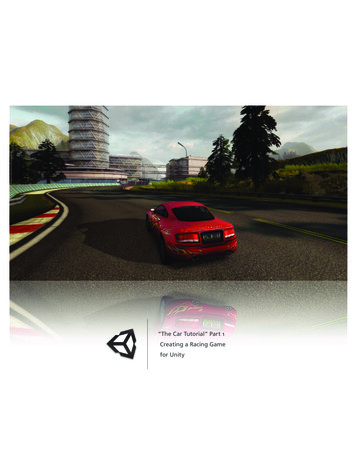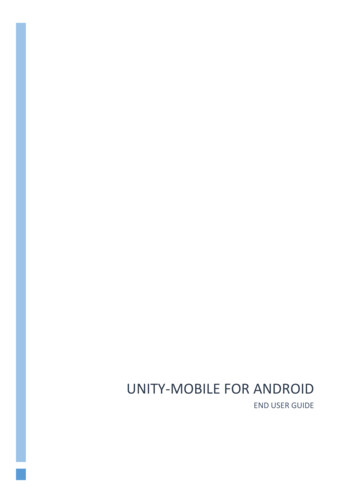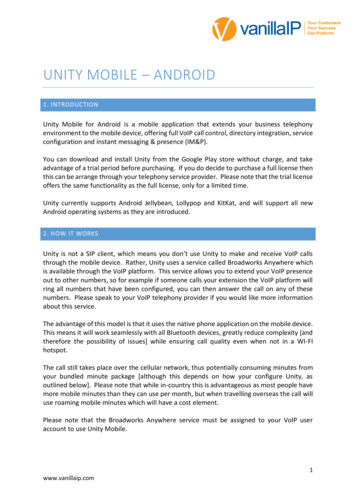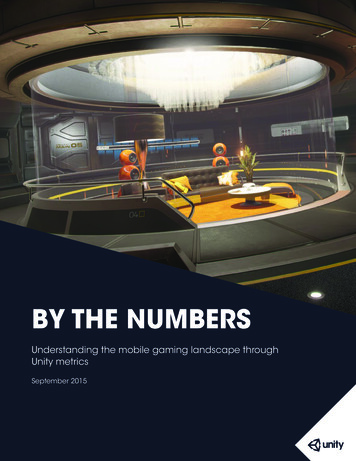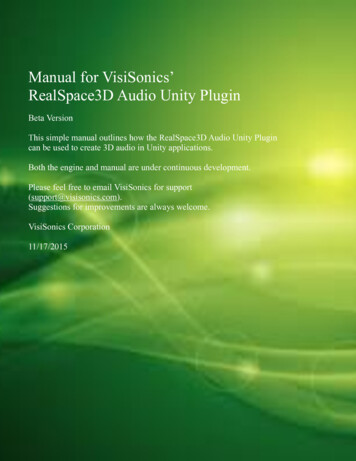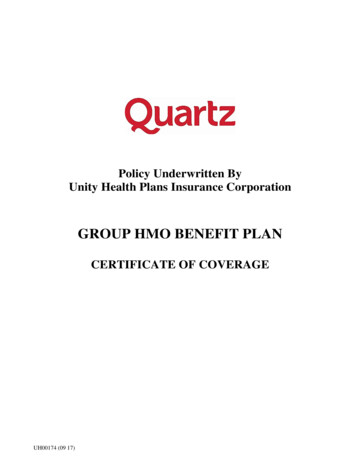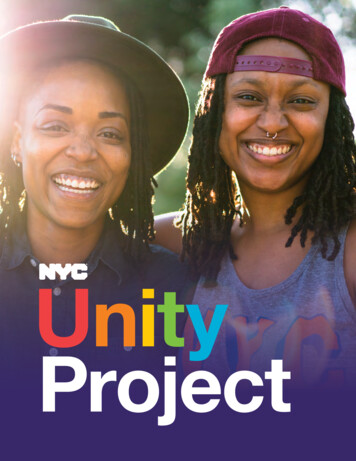
Transcription
UnityProject
Table of Contents4 Letter from First Lady Chirlane McCray6 Understanding Our Challenge10 Our Vision12 Safe16 Supported20 Healthy26 Looking Forward
Letter fromFirst LadyChirlaneMcCrayFor so many people – including me – New York City is the first place they ever truly felt athome. This is a city where 8.5 million people from all different backgrounds live and worktogether, and where everyone can find a sense of community.That’s what makes our city such a special and vibrant place. And it’s why, for so long, folkswho face discrimination and persecution elsewhere have made their home here.That includes our LGBTQ community, a treasured part of New York City’s past, present andfuture. Our LGBTQ New Yorkers contribute to the life of our city in countless ways – asleaders and public servants, as workers and entrepreneurs, as artists, thinkers and activists.The de Blasio administration and our partners across the City work hard every day to stand upfor all members of our LGBTQ community. In recent years we have worked to make ourschools safer and more affirming for our LGBTQ students and staff. We stood againstbathroom bigotry and made sure transgender New Yorkers can get an ID that reflects whothey are. We stepped up our efforts to prevent HIV and opened up beds for homeless LGBTQyouth who need a safe place to sleep.Even with all this progress, we still have much work to do. And that’s especially true when itcomes to our LGBTQ youth, who face unique challenges and significant barriers to opportunityand overall wellness.Half of LGBTQ youth in New York City report feeling sad or hopeless over extended periodsof time. LGBTQ teenagers are more likely than their non-LGBTQ peers to be rejected by theirfamilies and forced into homelessness. They are also more likely to be subject to datingviolence and to spend their school days hiding from bullying behavior, instead of learning inpeace. And tragically, LGBTQ young people are more than three times more likely to attemptsuicide than non-LGBTQ youth.We can do better for our young people. This blueprint is the City’s pledge to do better, and anarticulation of our historic, citywide commitment to supporting LGBTQ youth.With considerable new resources and a comprehensive, community-centered approach, we willbreak down the cultural and social barriers that hold LGBTQ youth back. We will work to reachevery single young person who identifies as LGBTQ with the services they need to be well, so noone falls through the cracks. And even as the Federal Government undermines key protectionsand supports for these vulnerable young people, we will expand and strengthen them.Together, we can help make New York City the safest place in the nation for LGBTQ youth.And we will make sure that all of our city’s young people – regardless of who they love or howthey express their identity – can be safe, supported and healthy as they proudly call New YorkCity home.First Lady Chirlane I. McCraynyc.gov/unityprojectNYC Unity Project4nyc.gov/unityprojectNYC Unity Project5
UnderstandingOur ChallengeNew York City has been a major center of life for the lesbian, gay, bisexual,transgender and queer or questioning (LGBTQ) community for decades.The birthplace of the modern LGBTQ1 rights movement, our city has longbeen a leader in the fight for dignity and equality for all.Given our history, it is no surprise that most youth who identify as LGBTQ inNew York City —whether they are native New Yorkers or moved here fromother parts of the country or world — grow and flourish and find strength inthe support of their friends, families and communities. In fact, statistically,New York City’s LGBTQ youth fare significantly better than national averages.This is at least in part because New York City provides a wide range of servicesthat support LGBTQ youth, from educational programs in our schools toshelter programs for homeless youth to mental health services.even in a citythat is relativelywell-positioned toserve LGBTQ youth,many vulnerableyoung people fallthrough the cracks.But historically, these services haven’t always been as coordinated as theyshould be. And not all LGBTQ youth know about the supports in place forthem. That means, even in a city that is relatively well-positioned to serveLGBTQ youth, many vulnerable young people fall through the cracks.Evidence demonstrates that New York City’s LGBTQ youth are far morelikely than their non-LGBTQ peers to experience an array of social, physicaland mental health challenges.2 Other facets of young people’s identities andCredit: Mayoral Photography OfficeIntersex is a general term used for a variety of conditions in which a person is born with a reproductiveor sexual anatomy that doesn’t seem to fit the typical definitions of female or male (Intersex Society ofNorth America). Many intersex people consider themselves part of LGBTQ communities, and sometimesthe “I” is added to the acronym. While this blueprint focuses on LGBTQ youth, the City is committed toincorporating the voices and needs of Intersex people into the programs and services we provide.1LGBTQ youth refers to youth who self‐identified as gay, lesbian, transgender and/or questioning of theirsexual orientation or gender identity. Sexual orientation was ascertained with the question: “Which ofthe following best describes you?” Youth who responded “homosexual,” “gay or lesbian,” or “bisexual”were categorized as LGBTQ. Gender identity was assessed with the question: “A transgender person issomeone whose biological sex at birth does not match the way they think or feel about themselves. Areyou transgender?” Youth who reported “Yes, I think of myself as a boy/man,” “Yes, I think of myself as agirl/woman,” “Yes, I think of myself some other way” were categorized as LGBTQ. Youth who responded2nyc.gov/unityprojectNYC Unity Project6nyc.gov/unityprojectNYC Unity Project7
experiences, such as race, ethnicity, class, ability and immigration status, oftenfurther determine their access to opportunities for success and happiness.3 A2015 survey that asked youth to report on their experiences over the previous12 months found alarming results4:Credit: Mayoral Photography OfficeLGBTQ youth in NYC21.6%21.6%20.4%24.5%of LGBTQ youth in NewYork City experiencedphysical dating violenceattempted suicideWe must work tomake sure that everyLGBTQ youth knowsthat New York City isthere to support them.experienced sexualdating violence10.8%lived away fromparents or guardiansbecause they werekicked out, wereabandoned, or ranaway from homewere bullied onschool propertyLGBTQ youth also experience disproportionate economic, housing and foodinsecurity. A 2015 survey of homeless and unstably housed youth in New YorkCity found that over half identified as LGBTQ.5All of these statistics underscore the urgency of our challenge. There are fartoo many LGBTQ young people in our city who do not feel welcome in theirhomes or schools, or who don’t feel safe in their communities, or even whenalone with an intimate partner. There are far too many LGBTQ youngpeople who don’t know where to turn for help, whether for guidance andsupport or for critical health services.To address these pressing needs, New York City must establish andstrengthen immediate supports for LGBTQ youth in crisis while working toeliminate the root causes of the disparities they so often face. Existingservices must be strengthened and better coordinated across the City so noyoung person falls through the cracks. And, we must work to make sure thatevery LGBTQ youth knows that New York City is there to support them.“not sure” to the sexual orientation question or “I don’t know” to the gender identity question may bequestioning their sexual orientation or gender identity, and were categorized as LGBTQ. However, it isalso possible that they did not understand the questions. Non‐LGBTQ youth refers to youth 1) who self‐identify as “heterosexual (straight)” to the sexual identify question and 2) who responded “No, I am nottransgender” and “I do not know what this question is asking” to the gender identity question.Burdge, H., Licona, A. C., Hyemingway, Z. T. LGBTQ Youth of Color: Discipline Disparities, SchoolPush-Out, and the School-to-Prison Pipeline. San Francisco, CA: Gay-Straight Alliance Network andTucson, AZ: Crossroads Collaborative at the University of Arizona, 2014.3New York City Department of Health and Mental Hygiene, Bureau of Epidemiology Services. Youth RiskBehavior Survey. New York, NY, 2015.4NYC Office of the Mayor, Center for Innovation through Data Intelligence. 2015 Youth Count Report.New York, NY, 2015.5nyc.gov/unityprojectNYC Unity Project8nyc.gov/unityprojectNYC Unity Project9
Goal 1Affirm the Value of LGBTQ Youth: Address Cultural Stigma, Homophobia, and TransphobiaOur VisionIn New York City, we want all young people – no matter their sexualorientation, gender identity or gender expression – to be safe, supportedand healthy.To realize this ambitious but achievable vision, the City of New York is proudto share its citywide commitment to supporting and celebrating LGBTQyouth. This unprecedented blueprint outlines the beginning of a coordinated,community-centered approach to address the unique challenges that LGBTQyoung people face in our city, deepen investments in key LGBTQ resourcesand programs and double down on our work to make New York City the mostwelcoming and affirming city in the world.Sixteen agencies across the City came together to survey existing programsand services, identify gaps and assess needs. We will work collectively toaddress the unique challenges faced by LGBTQ young people, using anapproach that recognizes the intersecting oppressions they endure based oncolor, neighborhood, class, ability, immigration status, language and manyother factors. There is a long way to go, but by reaching LGBTQ youth wherethey are – where they live, where they learn, and in their communities – theCity can help make sure all of our young people have the opportunity to leadfull lives and reach their potentials.Current Participating Agencies:.double down onour work to makeNew York City themost welcomingand affirming cityin the world.Administration forChildren’s ServicesNew York PoliceDepartmentDepartment of Health andMental HygieneCommission onHuman RightsDepartment of EducationChildren’s CabinetHuman ResourcesAdministrationMayor’s OfficeCommunity Affairs UnitDepartment ofHomeless ServicesCommission onGender EquityMayor’s Office to CombatDomestic ViolenceMayor’s Fund toAdvance New York CityNYC Health HospitalsMayor’s Center forFaith and CommunityPartnershipsDepartment of Youth andCommunity Developmentnyc.gov/TBDBe NYC: A Blueprint for Advancing the Health, Safety, and Success of LGBTQ Youth in NYC10nyc.gov/unityprojectNYC Unity ProjectMayor’s Office ofOperations11
Goal 1Affirm the Value of LGBTQ Youth: Address Cultural Stigma, Homophobia, and TransphobiaSafeEvery LGBTQ youth should be safe in New York City. Yet violence continues toplague the lives of far too many LGBTQ young people. They experience higherrates of intimate partner violence and bullying at school and online. And whenLGBTQ youth are forced out of their homes because of abandonment, rejectionor other reasons, they are especially vulnerable to violence and exploitation.The City is committed to preventing and reducing violence in all of itsforms, and to expanding and fortifying safe spaces throughout the City.We are working to help promote healthy relationships among young people,to build positive relationships between youth and the NYPD, to traineducators to intervene before violence and bullying occurs and to giveyoung people more safe places to go, in more parts of the city, at more timesof the day. And through our efforts, we aim to address the structural violencethat LGBTQ youth face, which is rooted in historical and contemporaryinjustices that perpetuate health inequities, such as access to quality careand safe living conditions.By working with agencies and partners across the City, we will make NewYork City the safest city in the world for LGBTQ youth.Where They LiveExpand services and hours at youth drop-in centers: The NYC Departmentof Youth and Community Development will establish its second 24-hour youthdrop-in center and also provide specialized services for LGBTQ youth at theseven existing youth drop-in centers. These centers offer an affirmingenvironment for LGBTQ teens who may have been forced to leave home or areotherwise in need of refuge.“I made it and it’s thanks toMarsha’s House and itsworkers. I couldn’t havemade it without y’all.”— Tarrik A,Recent Marsha’s House ResidentEstablish the first-ever LGBTQ shelter for young adults: In partnershipwith Council Member Ritchie Torres, in early 2017 the NYC Department ofHomeless Services opened Marsha’s House - the first LGBTQ-specific shelterin the adult system, named for famed LGBTQI activist Marsha P. Johnson.Marsha’s House currently offers shelter to nearly 90 homeless young adults, 30years and under, in a welcoming and supportive space providing targetedLGBTQ-relevant services and resources.Provide young people in need with a safe place to sleep: Left with veryfew options, young people who age out of youth housing often fall throughthe cracks. To keep this from happening, and to make sure that beds areavailable for youth in need, the NYC Department of Youth and CommunityDevelopment and the NYC Department of Homeless Services have beguncollaborating to streamline access between the two services6. For those whoage out of youth-specific residential programs, the City is streamlining the6nyc.gov/TBDBe NYC: A Blueprint for Advancing the Health, Safety, and Success of LGBTQ Youth in services-review.pdfNYC Unity Project13
“The RAPP Program has done so muchfor me. Before RAPP I went to a Catholicschool where I was taught that“homosexuality and being different” was“wrong.” I was in a world of hate andprejudice and I hated myself and thatwas all that I could think about. As soonas I was able to join RAPP I was shownfull support, acceptance, and care. RAPPhas helped me make my voice heard andthey appreciated that voice. They taughtme to love myself, something I couldnever even think about without them.”— Angelina B, 10th grader in Manhattantransition process into the adult and family shelter system,including eliminating the additional screening and intakeprocess. And, as some young people in the adult or familyshelter system can be better served by youth shelters, intakestaff in the adult and family system are now equipped to trackvacancies in youth programs and identify specific open beds foreligible young people. This improved coordination between cityagencies has expanded options for young people in need of asafe place to sleep.Support healthy LGBTQ relationships: The City will expandand update trainings to promote healthy relationships amongyoung people. Too often, existing trainings neglect LGBTQexperiences, even though these young people experiencehigher rates of partner violence than their straight andcisgender peers. nyc.gov/unityprojectNYC Unity Project ealthy Relationship Training Academy: The NYC Mayor’sHOffice to Combat Domestic Violence will update its HealthyRelationship Training Academy curricula to includeLGBTQ-affirming training materials. These materials,which will reach more than 8,000 participants in the 2017-18school year, will address teen dating experiences andchallenges specific or especially relevant to LGBTQ students.These new materials and curricula will be developed withinput from the NYC Human Resource Administration’sRelationship Abuse Prevention Program (RAPP) SummerPeer Leadership Program Academy, which served over 150youth leaders from over 80 different schools in 2017. Initialcurriculum updates have expanded discussions onmasculinity, femininity and nonconformity, as well asimplemented the use of more inclusive gender pronouns. elationship Abuse Prevention Program (RAPP): ThroughRRAPP, the NYC Human Resources Administration willcontinue its ongoing work to train students in recognizinghealthy relationships. RAPP workshops will reach over 3,500youth, enabling them to recognize and intervene in instancesof relationship abuse. RAPP will also continue to providerelationship counseling services, reaching 7,500 youth of allsexual orientations and gender identities. RAPP will alsoexpand awareness efforts for parents and families, improvingtheir understanding of relationship violence in the lives ofthe City’s young people and of available strategies to helpthem stay safe.14Where They LearnOpen single occupancy bathrooms in every school:By January 2018, the NYC Department of Educationwill make single occupancy restrooms available inschools citywide. These restrooms will better supportstudents with additional privacy needs, includingtransgender and gender-nonconforming students aswell as students with medical conditions and disabilities.Each restroom will have clear and appropriate signage,safety locks with administrative keys and free menstrualproducts in middle and high schools.“I have had the privilege of launching the Out For SafeSchools Badge Campaign at two different schools overthe last 3 years. In both schools, almost every teacher,administrator, and staff member (including security)opted to participate by displaying a badge. Oncedisplayed, students will say things like ‘Why do all theteachers have those?’ and ‘Thank you! I know I can bemyself in your class.’This year, one of my students came out as a TransgenderMale. While brainstorming supports for him before theyear started his sister said, ‘I know you will be safe inyour history class because that teacher always wearsthat rainbow badge around her neck every day. Thatmeans she will have your back.’ The visibility alonemakes students be and feel safer. LGBTQ students inschools with this program are safer because the staffmembers are aware and opting to create inclusive andaffirming environments of school and class culture.”— High School Health Educator in QueensExpand and strengthen network of visible schoolallies: The NYC Department of Education will expandthe OUT for Safe Schools Badge campaign, a nationalinitiative of the Los Angeles LGBT Center and GSANetwork that supports school staff in outwardlyidentifying themselves as allies to LGBTQ and gendernon-conforming students. Since 2015, over 20,000badges have been issued to staff at more than 250 NYCschools. The City will train 400 additional school staffmembers who volunteer to participate in the campaign,and provide them with badges and ongoing support fornyc.gov/unityprojectNYC Unity Projecttheir schools. The trainings will help staff recognize andinterrupt bias-based remarks, use inclusive language andrefer students to appropriate resources.In Their CommunityExpand safe and inclusive community spaces:Through the “OUT for Safe Spaces” campaign, theNYC Department of Health and Mental Hygiene seeksto replicate the success of the OUT for Safe Schoolsprogram, by working in other spaces where youngpeople congregate – including clinics, youth-servingorganizations and faith based organizations. Non-schoolpartners who take the OUT for Safe Spaces pledge aretrained in how to create more inclusive spaces for theirLGBTQ clients. This training covers how to addressLGBTQ youth, including clarity on terminology andthe importance of inclusivity for the health and safety ofLGBTQ youth. By the end of the year, 100 partners willhave taken the pledge to promote safe spaces.Engage communities to stop violence: The NYCDepartment of Health and Mental Hygiene willdevelop new LGBTQ-specific educational materials forthe Cure Violence program, which has helped reducegun violence in the City through the use of communitymembers as violence interrupters. The new materialswill help expand community understanding of therelationship between gender identity and expression,power and violence, including violence against theLGBTQ community.Foster positive relationships with police: The NYCDepartment of Education will partner with the NewYork Police Department to provide Know Your Rightstrainings to Gender and Sexuality Alliances (GSAs) inschools, beginning in fall 2017 with a pilot program fortargeted schools before expanding in clusters to GSAsacross the five boroughs. LGBTQ youth – especiallytransgender and gender non-conforming youth – canface hostility in a variety of environments, so it isespecially important that they understand how andwhen to seek support from a police officer. Theworkshops also offer NYPD officers a chance to heardirectly from LGBTQ students in their communities.15
Goal 2Meet the Needs of LGBTQ Youth: Reduce Barriers to Culturally Competent ServicesSupportedAll LGBTQ youth should feel supported in New York City. Whether at home,in school or elsewhere in the community, they should be able to turn totrusted adults who understand what they’re going through, support themunconditionally and can guide them to affirming resources. And they shouldhave access and exposure to peer networks that will do the same.That’s why the City is committed to fostering allies and strengtheningsupports for LGBTQ young people among the people who matter most intheir lives: families, peers, teachers, faith communities and employers. Byreaching LGBTQ youth where they live, learn, worship and work, we canhelp make the environments around them more empowering, respectful,affirming and supportive.Where They LiveFacilitate family conversations: In partnership with LGBTQ-affirmingcommunity organizations, the NYC Commission on Human Rights will hostworkshops for parents to help facilitate supportive family conversationsaround sexuality, gender identity and expression, and the challenges thatLGBTQ youth face. These workshops will provide a venue for parents andyouth to broaden their understanding of LGBTQ identities, especiallytransgender and gender non-conforming identities.Tackle stigma among families: The City will launch an extensivecommunications campaign to encourage parents, caregivers and chosenfamilies of LGBTQ youth to accept and affirm youths’ identities. Thecampaign will make parents and families aware of available City resources,tools and support systems that can help them better understand theexperiences of the young people in their care.Where They LearnIncorporate LGBTQ-content in the classroom: To empower teachers toincorporate age-appropriate LGBTQ content into their lessons, the NYCDepartment of Education is partnering with content providers such as theLambda Literary Foundation, WNET and History UnErased to developlesson plans, resources and discussion guides for subject areas across gradelevels. Beginning in the 2017-18 school year, these resources will be availableto all City teachers across grade levels and subject area. Through programsdesigned to help teachers and students utilize these resources in theclassroom, we will expand LGBTQ inclusive curriculum across all boroughs.NYC students should graduate from high school with an awareness andunderstanding of the amazing contributions of the LGBTQ community.nyc.gov/TBDBe NYC: A Blueprint for Advancing the Health, Safety, and Success of LGBTQ Youth in NYC16nyc.gov/unityprojectNYC Unity Project17
In Their Community“In our experience at Kolot Chayeinu/Voices of OurLives, it is crucial for LGBTQ young people, perhapsespecially trans youth, to find a warm welcome in theirfaith community, a welcome that says in effect, ‘Comeas you are.’ To arrive at that welcome, though, means alot of work on the part of clergy, staff and members tolearn to use new pronouns, to ensure there are clearlylabeled gender-neutral bathrooms, to show photos ofLGBTQ youth on websites and in social media, and tohire queer and trans staff and teachers who can serveas especially needed role models. We are delighted thatthe First Lady is launching this city-wide initiative toteach us all.— Rabbi Ellen Lippmann,Kolot Chayeinu/Voices of Our Lives, BrooklynEngage teachers to share learning experiences and best practices:The inaugural LGBTQ Inclusive Curriculum Conference was held in June 2017 andreached more than 150 educators from Pre-K to 12th grade across all five boroughs.The conference, which provides an in-person opportunity for educators to learn andgrow in their teaching practices, will more than double in size, supporting between350 and 400 educators. These educators cover subjects such as social studies, EnglishLanguage Arts and music, and teach students from our earliest learners in Pre-K allthe way through special programs for overage high school students. With an increasein attendees comes the opportunity to offer more workshops throughout the day, achance for networking across the city and a commitment by the City of New Yorkthat teachers should be supported in teaching diverse content to our students.“I am a newfound Syrian resident of NYC who’sjourneying through an array of opportunities anddownfalls in life. Gay Men’s Health Crisis (GMHC) is anaffirming and identifying agency right from its name; itgives me a sense of belonging, amicability, andinspiration. The Career Advance program within GMHChelps LGBTQIA youth, who are HIV negative, also takepart in the breadth of social services available atGMHC. I am grateful for the encouragement andsupport I receive as a participant in the career advanceprogram. I will be attending a LGBT expo because of thedirect referral from Career Advance job developers andI am extremely grateful and excited to attend.”— R.A., YouthPathways Youth Client, ManhattanStrengthen and expand GSAs: The NYC Department of Education will expand itssupport for GSAs in schools, which already exist across the five boroughs. Expandedsupport will include key trainings for any GSA that requests them, including in theareas of healthy relationships, suicide prevention and leadership. In spring 2018,more than 300 advisors and student leaders will come together for an inaugural GSASummit to develop strategies to support the growth of new and existing GSAs.Additionally, every guidance counselor will be equipped with a resource guide to helpstudents start a GSA at their school.nyc.gov/unityprojectNYC Unity Project18nyc.gov/unityprojectNYC Unity ProjectBuild a supportive faith network: The NYC Departmentof Health and Mental Hygiene, the NYC Commission onHuman Rights and the NYC Community Affairs Unit’sCenter for Faith and Community Partnerships will engagefaith leaders to develop a network of LGBTQ-affirmingfaith communities. Faith communities often serve asimportant sources of guidance and values for youth andtheir families, but they can also sometimes marginalizeLGBTQ youth, furthering their feelings of exclusion andundercutting their self-worth. To launch this network, theCity will host a summit of more than 100 faith leadersthis winter, with the goal of engaging hundreds morefaith leaders over the next two years to help reducestigma, promote respect and improve understanding ofLGBTQ issues.Unlock employment opportunities: The City is nowproviding targeted employment assistance to LGBTQyouth, noting their unique challenges in the workplace.The NYC Career Pathways framework, which helps NewYorkers access job training and career opportunities,will tailor its resources to better serve the LGBTQcommunity, including the Human ResourceAdministration’s YouthPathways, which reaches up to14,500 youth each year. Every participating youth clientwill have the option of enrolling in the tailored careerservices programming.Foster supportive workplaces: By summer 2018,following extensive community engagement, the NYCDepartment of Youth and Community Development andthe Center for Youth Employment will develop a bestpractices manual for NYC youth workforce providersand employers to implement LGBTQ-friendly practices.Agencies across the City will partner with the youthworkforce provider community to create the manual,which will promote cultural sensitivity and helpemployers make LGBTQ youth feel supported in theworkplace and on the job hunt.19
HealthyIn New York City, all LGBTQ youth should have the opportunity to leadhealthy lives. That means having access to healthcare professionals whounderstand their unique needs in terms of both mental and physical health,as well as comprehensive programs for treatment and prevention. It alsomeans having the physical, social and emotional tools to be well.The City is committed to promoting the health and well-being of all youngpeople, including LGBTQ youth. The first step is making sure young peopleknow about the many health resources available to them and then reachingthem where they are with critical services.Where They LiveTrain therapists to foster healthy family relationships: In partnershipwith the NYC LGBT Community Center, the NYC Administration forChildren’s Services is supporting the LGBTQ Institute for Family Therapy(LIFT) free training programs for therapists, equipping the City’s preventiveservices mental health clinicians to guide 300 families in accepting, affirmingand supporting LGBTQ youth. Through a six-month certification program,LIFT participants build knowledge and skills in coaching families of diversebackgrounds through understanding and accepting youths’ gender identities,gender expressions and sexual orientations.Tailor NYC Well resources: Through ThriveNYC, the NYC Departmentof Health and Mental Hygiene is sharing a list of LGBTQ-knowledgeableproviders with all NYC Well staff. NYC Well is New York City’s one-call,one-click connection to mental health care (1-888-NYC-WELL). This freeand confidential helpline is available for anyone who needs it. Now, whenLGBTQ youth seek help and support, counselors and peer specialists will bebetter equipped to direct them, via a user-friendly database, to cultu
nyc.gov/unityproject NYC Unity Project 4 nyc.gov/unityproject NYC Unity Project 5 For so many people - including me - New York City is the first place they ever truly felt at home. This is a city where 8.5 million people from all different backgrounds live and work together, and where everyone can find a sense of community.

